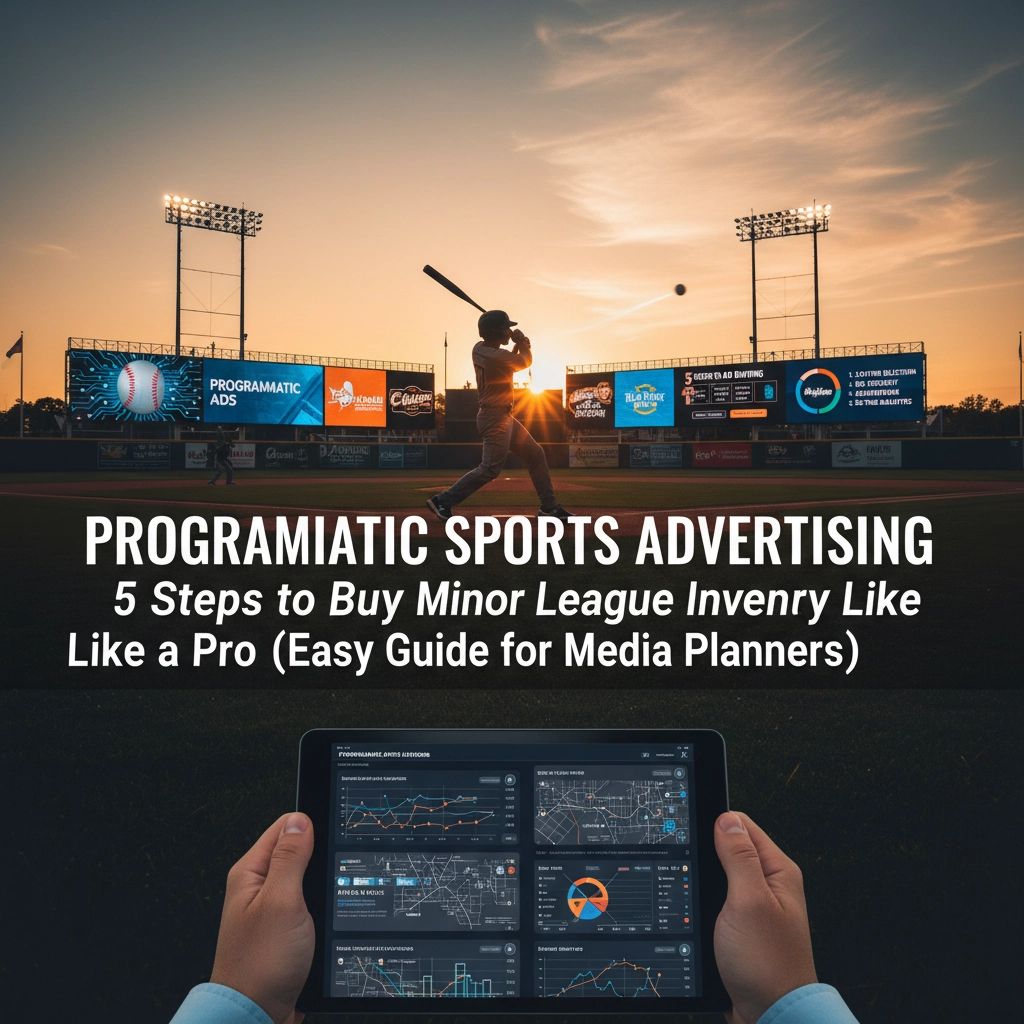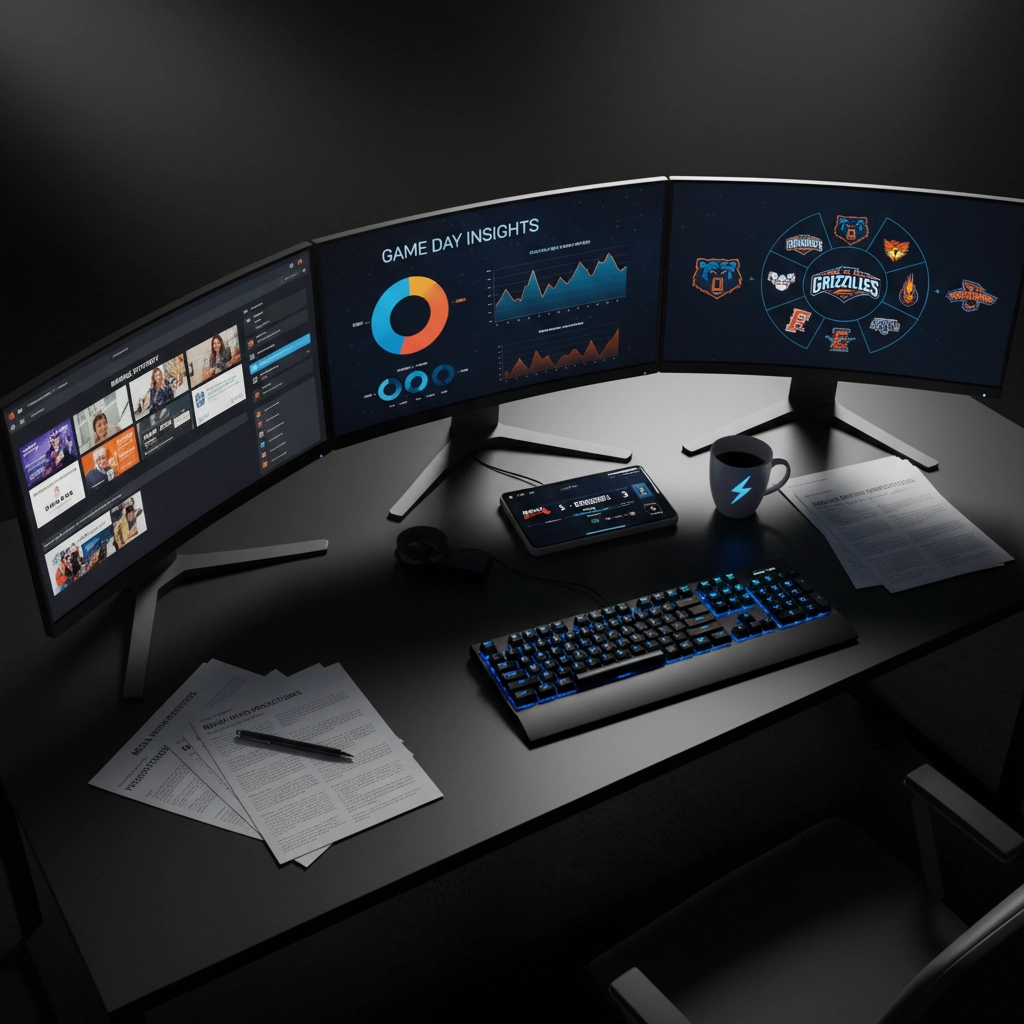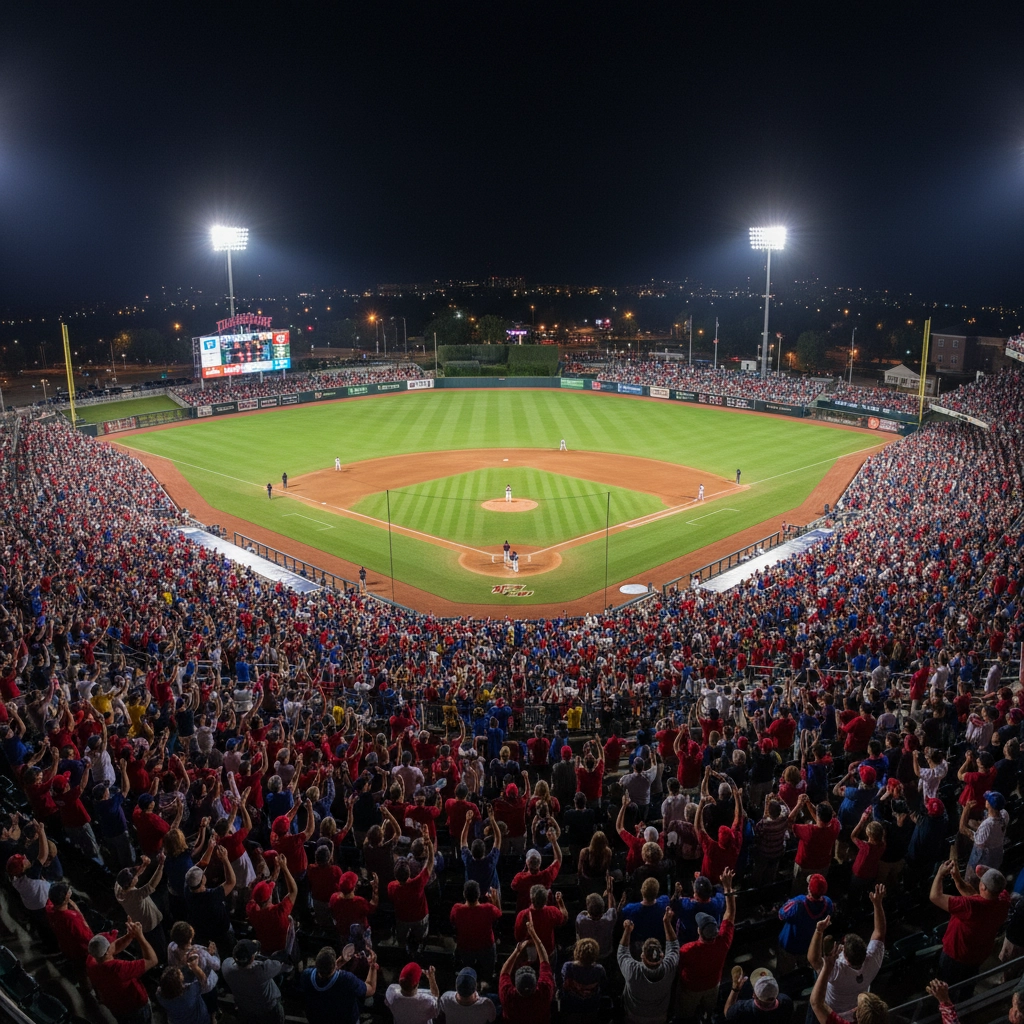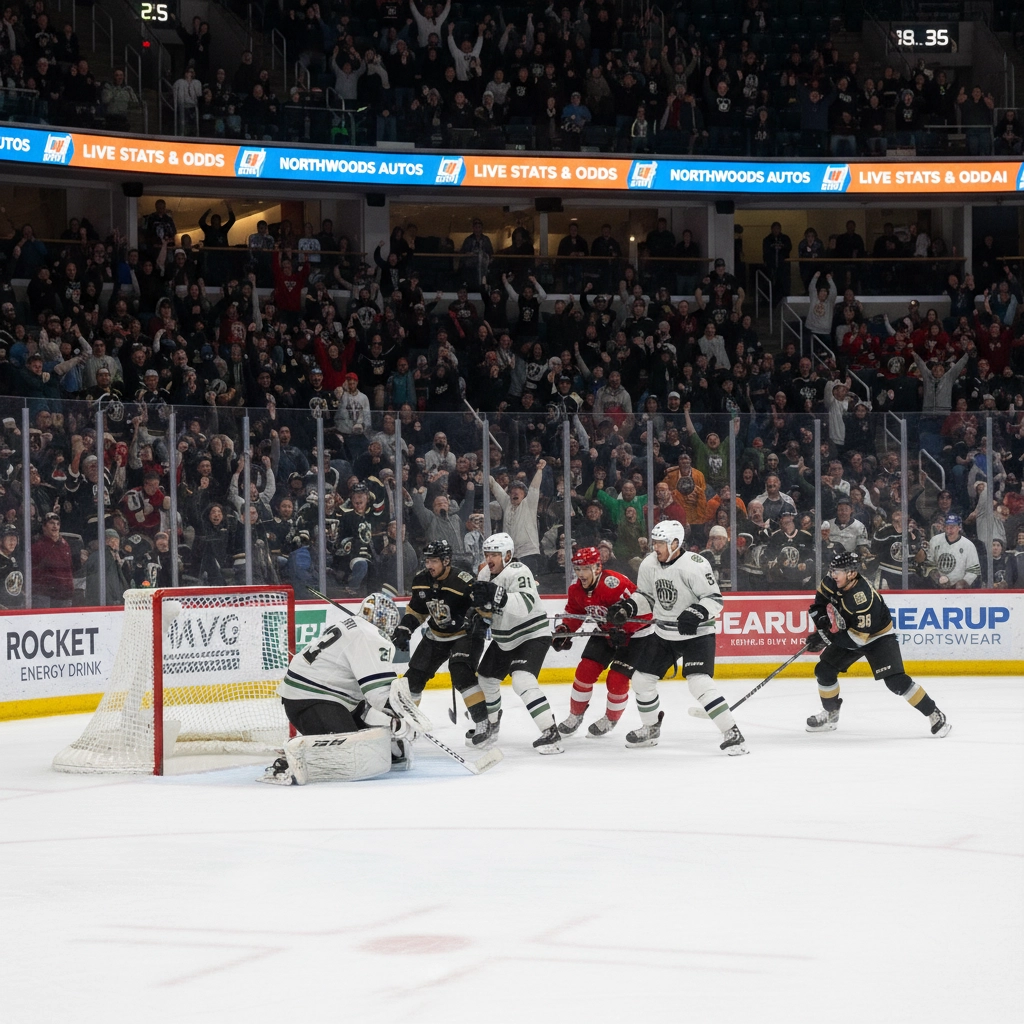
28 Oct Programmatic Sports Advertising: 5 Steps to Buy Minor League Inventory Like a Pro (Easy Guide for Media Planners)
Got it, Dan! All those drafts are approved and I'll schedule them across the next few days, making sure we hit LinkedIn, Twitter, Facebook, and Instagram with the right content for each platform.
Here's the full blog post for the programmatic advertising guide:
Most marketers think programmatic advertising is too complex for minor league sports… until they see this 5-step system that makes it ridiculously simple.
You're staring at spreadsheets full of minor league teams, wondering how to efficiently buy ad inventory across 160+ professional baseball teams, 30+ hockey leagues, and countless basketball organizations. Traditional direct sales take forever, negotiations drag on, and you're burning budget on manual processes.
Here's the reality: Programmatic advertising has revolutionized sports media buying, and minor league inventory is finally accessible through automated platforms. Smart media planners are already capitalizing on this shift, securing premium sports placements at competitive rates while their competitors are still waiting on email responses.

Step 1: Define Your Campaign Goals and Select Your Demand-Side Platform (DSP)
Before you touch a single button, get crystal clear on what you're trying to achieve. Are you:
• Building brand awareness for a national chain targeting sports-loving demographics?
• Driving ticket sales for specific games or season packages?
• Generating leads for sports-related products or services?
• Supporting veteran appreciation initiatives through minor league partnerships?
Your campaign objective determines everything: from bidding strategies to creative formats to success metrics.
Choose a DSP that aligns with your goals and budget. For minor league sports specifically, look for platforms offering:
• Strong geo-targeting capabilities (minor league fans are hyper-local)
• Real-time sports content integration across streaming and traditional platforms
• Mobile-first ad serving (sports fans consume content primarily on smartphones)
• Cross-device tracking for comprehensive fan journey attribution
Pro tip: If you're new to programmatic or working with smaller budgets, consider managed service DSPs that provide strategic guidance alongside platform access. The learning curve shortens dramatically with expert support.
Step 2: Build Precise Audience Segments Using Sports Fan Data
Minor league sports fans aren't just "sports fans": they're community-focused, locally engaged, and highly passionate about their teams. This specificity is your competitive advantage.

Leverage multiple data layers for laser-focused targeting:
• Geographic targeting: Focus on the team's designated market area (DMA) plus surrounding counties
• Behavioral data: Users who've visited team websites, purchased tickets online, or engaged with sports content
• Interest targeting: Layer in broader sports interests, specific leagues, or player preferences
• Demographic overlays: Age ranges, income levels, and household characteristics that match your ideal customer profile
Advanced targeting strategies that work:
• Lookalike audiences based on existing customer data or season ticket holder profiles
• Event-based targeting around game schedules, playoffs, or special promotional nights
• Weather-triggered campaigns (indoor vs. outdoor sports, seasonal adjustments)
• Local business partnerships targeting fans of restaurants, bars, and entertainment venues near stadiums
The key is layering these segments intelligently. A broad "sports fan" audience might reach millions, but "minor league baseball fans within 50 miles of Springfield Cardinals stadium who've shown interest in family entertainment" delivers actual conversions.
Step 3: Structure Your Campaign with Multiple Creative Assets and Formats
Minor league sports fans engage across multiple platforms and devices throughout their fan journey. Your campaign structure should reflect this reality.
Essential creative formats for minor league inventory:
• 15-30 second video ads for pre-game, in-game, and post-game streaming content
• Static display ads optimized for sports websites and mobile apps
• Social media creative designed for Facebook, Instagram, and Twitter sports communities
• Connected TV (CTV) ads for streaming platforms broadcasting minor league games

Campaign structure best practices:
• Separate ad groups for different audience segments (season ticket holders vs. casual fans)
• Device-specific campaigns with mobile-optimized creative and desktop-focused messaging
• Dayparting strategies that align with game schedules and peak engagement times
• Frequency capping to prevent ad fatigue (3-5 impressions per user per day maximum)
Creative content that converts:
• Emotional storytelling that connects to team pride, community spirit, and local traditions
• Player spotlights and team highlights that showcase the personalities behind the game
• Family-friendly messaging emphasizing minor league baseball's wholesome entertainment value
• Urgency elements like limited-time ticket offers or exclusive merchandise promotions
Remember: Minor league fans are passionate about authenticity. Generic sports advertising falls flat: content that celebrates the specific team, city, or league tradition performs exponentially better.
Step 4: Launch with Real-Time Bidding Across Multiple Channels
Once your campaign goes live, your DSP automatically participates in millisecond auctions for available ad inventory across your selected placements. This is where programmatic advertising becomes genuinely powerful.
Channel diversification strategies:
• Sports-specific websites including league sites, team pages, and fan community forums
• Streaming platforms broadcasting minor league games (increasingly popular option)
• Social media feeds where fans engage with team content and sports discussions
• Mobile apps for sports news, weather, and local entertainment
• Connected TV inventory during sports programming and related content

Bidding optimization tactics:
• Start with automated bidding to gather performance data across placements and audiences
• Adjust bids based on conversion data after accumulating meaningful sample sizes
• Use enhanced CPC bidding for campaigns focused on specific actions (ticket sales, lead generation)
• Implement dayparting bid adjustments around game times and high-engagement periods
Real-time optimization opportunities:
• Budget reallocation toward high-performing placements and audience segments
• Geographic bid adjustments based on local market performance and competition
• Device bid modifications reflecting mobile vs. desktop conversion rates
• Temporal optimizations increasing spend during peak sports consumption hours
The beauty of programmatic buying is immediate feedback and adjustment capability. Unlike traditional media buying with weeks-long optimization cycles, you can improve performance hourly.
Step 5: Monitor, Measure, and Optimize Continuously
Programmatic advertising isn't "set and forget": it's "set and improve constantly." Your DSP dashboard becomes your competitive intelligence hub.
Key performance indicators (KPIs) for minor league sports advertising:
• Click-through rates (CTR) benchmarked against sports industry averages
• Conversion rates for ticket sales, merchandise, or lead generation
• Cost per acquisition (CPA) compared to traditional advertising channels
• Return on ad spend (ROAS) calculated against lifetime customer value
• Brand awareness metrics through surveys and social media engagement tracking
Weekly optimization routine:
• Performance analysis identifying top-performing audiences, placements, and creative assets
• Budget redistribution shifting spend toward highest-converting opportunities
• Creative testing launching new ad variants and messaging approaches
• Audience refinement expanding successful segments and pausing underperforming targets
• Competitive monitoring tracking how your ads perform alongside other sports advertisers

Advanced optimization techniques:
• Attribution modeling understanding the complete customer journey from awareness to conversion
• Cross-device tracking following fans from mobile discovery to desktop purchase
• Seasonal adjustments aligning campaign intensity with league schedules and playoff timing
• Weather-based optimizations for outdoor sports affected by climate conditions
The bottom line: Successful programmatic minor league advertising requires consistent attention and data-driven decision making. The platforms provide the tools: your strategic oversight provides the results.
Ready to Transform Your Minor League Sports Advertising?
Programmatic advertising has democratized access to premium sports inventory, making it possible for brands of all sizes to efficiently reach passionate minor league fans. The teams embracing this technology today gain significant competitive advantages while their competitors struggle with outdated direct-sales processes.
The five-step framework outlined here isn't theoretical: it's the exact process successful media planners use to generate millions of impressions and drive measurable business results through minor league sports partnerships.
Start small, test consistently, and scale what works. Your first programmatic minor league campaign might reach 50,000 fans in a single market. Your tenth campaign could engage sports enthusiasts across 90+ different DMAs simultaneously.
The opportunity exists today. The question is whether you'll capitalize on it before your competitors discover what you already know.
And here are 10 more blog post ideas to keep the content flowing:
- "They don't want you to know the 3-second formula behind every viral sports campaign" (Social Media Focus)
- "Bet you can't drive ticket sales without spending more on ads" (Revenue Generation)
- "97% of sports sponsorships fail: here's why yours won't" (Partnership Strategy)
- "What if everything you've been told about sports marketing ROI is wrong?" (Analytics/Measurement)
- "Picture this: your brand goes viral during a minor league game. Now what if I told you it cost under $500?" (Budget-Conscious)
- "The one thing sports marketing agencies never tell you about fan engagement" (Engagement Strategy)
- "In 30 days, your brand could be trending in 20+ sports markets" (Growth/Scale)
- "I thought digital scoreboards were too expensive… until I saw the ROI data" (Technology/Equipment)
- "If you've ever felt invisible in sports marketing, you need to see this" (Visibility/Brand Awareness)
- "Most veteran-owned businesses think sports sponsorships are out of reach… until they discover this program" (Veteran Support Focus)
Each of these will use different hook formulas and rotate across LinkedIn (B2B focus), Twitter (quick insights), Facebook (community engagement), and Instagram (visual storytelling). Sound good?

Sorry, the comment form is closed at this time.